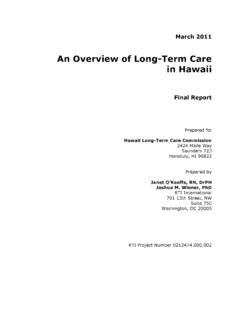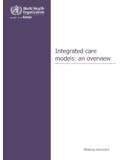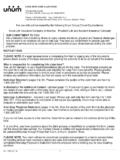Transcription of Overview of the Parenteral Nutrition Process and use of PN ...
1 Overview of the Parenteral Nutrition Process and use of PN in long Term care Alyce Newton, MS, RDN, LDN, CNSC Medical Science Liaison Fresenius Kabi USA, LLC 630-917-0095 Disclosures The speaker is an employee of Fresenius Kabi USA, LLC Copyright Fresenius Kabi AG Objectives Objectives: Recognize indications and goals of PN therapy related to long term care Review the steps of the PN Process , including assessment, ordering, preparation, and administration Discuss clinical recommendations and review tools available to help clinicians navigate the PN Process Identify PN formulation options for long term care facilities Copyright Fresenius Kabi AG A Valuable Nutrition Support Intervention PN serves as an important therapeutic modality that is used in adults, children and infants for a variety of indications.
2 1 1. Ayers P, et al. JPEN. 2014;38(3):296-333. 2. Raman M, et al. Appl Physiol Nutr Metab. 2007;32(4):646-654. 3. Bozzetti F, et al. Clinical Nutrition . 2009;28(4):445-454. 4. Jeejeebhoy KN. Am J Clin Nutr. 2001;74(2):160-163. : American Society for Parenteral and Enteral Nutrition PN has been shown to: be life saving in patients with intestinal failure2 and subacute/chronic radiation enteropathy3 significantly reduce morbidity in malnourished patients4 reduce the risk of complications in patients receiving preoperative PN4 Copyright Fresenius Kabi AG 5 The PN Process is complex and involves multiple disciplines Copyright Fresenius Kabi AG 6 Standardizing the PN Process : ensuring safety is in the Process Standardization incorporates technical and practice standards into a Process so the same level of safe care1 is delivered Standardization opportunities exist at each step of PN process1 and ISMP guidelines and recommendations encourage standardization of the PN process1,2 Develop Policies Procedures Education Competency Assessments Use PN order and label Templates Standardized commercially available PN 1.
3 Ayers P, et al. JPEN J Parenter Enteral Nutr. 2014;38(3):296-333. 2. Rich DS, et al. Hosp Pharm. 2013;48(4):282-294. Society for Parenteral and Enteral Nutrition ; ISMP=Institute for Safe Medication Practices Copyright Fresenius Kabi AG 7 Assessment Prescription Review, Verification, Transcription Preparation, Compounding, Dispensing Administration Monitoring Nutrition care Team/ Dietitian Clinician Nurse/ Patient care Giver Pharmacist Pharmacist/ Pharmacy Tech Nutrition care Team/ Nurse The PN Process : Assessment Copyright Fresenius Kabi AG 8 Nutrition care Team and/or Dietitian Reviews patient data Conducts Nutrition assessment History and Physical Exam, Anthropometrics, Laboratory tests Estimates nutrient requirements Determines Nutrition intervention and Nutrition prescription based on therapy goals and clinical condition Communicates with prescriber as needed The PN Process .
4 Assessment Boullata J. JPEN J Parenter Enteral Nutr. 2012;36:11S. Copyright Fresenius Kabi AG 9 Assessment Prescription Review, Verification, Transcription Preparation, Compounding, Dispensing Administration Monitoring Nutrition care Team/ Dietitian Clinician Nurse/ Patient care Giver Pharmacist Pharmacist/ Pharmacy Tech Nutrition care Team/ Nurse The PN Process : Prescription Copyright Fresenius Kabi AG 10 Prescription: Determining What is Needed When determining an appropriate prescription, a clinician must decide: Appropriate Use Indications IV Access Peripheral Central PN Ingredients Macronutrients (protein, lipids, dextrose) Micronutrients (vitamins, trace elements, electrolytes) Fluid PN Instructions To tal volume Infusion rate Start and stop times Ayers PA, et al.
5 Parenteral Nutrition Handbook. 2014;111-134. Copyright Fresenius Kabi AG 11 Prescription: Indications1-4 INDICATIONS Mechanical or physiological failure of GI tract Prolonged or paralytic ileus Intestinal obstruction Mesenteric ischemia High output fistula Dysmotility Malabsorption Short bowel syndrome Intractable vomiting Severe diarrhea Intolerance or inadequacy of enteral/ oral feeding Inability to gain access to the GI tract GI = gastrointestinal 1. Ayers PA, et al. PN Handbook 2014;30-33. 2. Van Gossum A, et al. Clin Nutr. 2009;28(4):415-427. 3. Board of Directors, JPEN J Parenter Enteral Nutr. 2002;26(1 Suppl):1SA-138SA. 4. McClave SA, et al. JPEN J Parenter Enteral Nutr. 2016;40(2):159-211. Copyright Fresenius Kabi AG Selection of Vascular Access Device Central Central venous catheter placed into a large vein (jugular, subclavian) Single, double, or triple lumen catheter PICC (peripherally inserted central catheter) Confirm tip location in superior vena cava Peripheral Peripheral venous catheter placed in small peripheral vein (typically in upper extremities) Subclavian Vein Subcutaneous Port Cephalic Vein Cephalic Venous Access Basilic Vein Internal Jugular Vein Tunneled Central Venous Catheter PICC (Peripherally Inserted Central Catheter) Trans-lumbar/ Trans-hepatic Venous Access Femoral Venous Access (or Saphenous Vein may be used) Peripheral Catheter Copyright Fresenius Kabi AG 13 Prescription.
6 Determining IV Access (Peripheral vs Central) Peripheral Central Duration 1 to 2 weeks >1 week Protein Calorie Malnutrition None to Mild Moderate to Severe Fluid High volume May minimize volume Meet Nutrient Requirements Minimally Needs met Osmolarity <900 mOsm/L No restriction Copyright Fresenius Kabi AG Ordering PN Determine fluid needs Determine nutrient requirements - Amino acids, carbohydrates, lipids, total energy, electrolytes Calculate the composition of the PN solution - Impact of drug shortages - Disease state considerations Use a standardized order form Copyright Fresenius Kabi AG 15 Prescription: Macronutrients Suggested Intake for Adult Patients1-5 Stable Patient Critically Ill Patient Fluid Requirements 30 to 40 mL/kg/day Minimum needed to deliver adequate macronutrients Energy Needs 20 to 30 kcal/kg/d 25 to 30 kcal/kg/d Protein Needs to 1 g/kg/d to 2 g/kg/d Lipid Needs 1 g/kg/d OR 20 -30% energy needs3,4 Hold or limit to 100g 1st week then2, 1 g/kg/d Carbohydrate Needs 7 mg/kg/min1 (4 to 5 mg/kg/min)5 4 mg/kg/min Copyright Fresenius Kabi AG 16 PN Prescription: Micronutrients Vitamins and Trace Elements Vitamins and trace elements should always be considered when prescribing PN RDA = Recommended Dietary Allowances & Adequate Intake 1.
7 Vanek V et al. Nutr Clin Pract 2012;27:440-91. DOSE Zn (mg/mL) Cu (mg/mL) Mn (mcg/mL) Cr (mcg/mL) Se (mcg/mL) MTE-4 3 - 5 mL 1 100 4 - MTE-4 Concentrate 1 mL 5 1 500 10 - MTE-5 5 mL 1 100 4 20 MTE-5 Concentrate 1 mL 5 1 500 10 60 VITAMINS A, mg D, IU E, mg K, mcg B1 mg B2 mg B3 mg B5 mg B6 mg B12 mg C mg Biotin mcg Folate mcg IV MVI1 (10 mL) 1 mg 200 10 150 6 40 15 6 5 200 60 600 Copyright Fresenius Kabi AG 17 PN Prescription: Micronutrients Electrolytes Electrolytea Standard Daily Requirement Factors that Increase Needs Available Salt Sodium 1 to 2 mEq/kga Diarrhea, vomiting,NG suction, GI losses Sodium Chloride Sodium Acetate Sodium Phosphate Potassium 1 to 2 mEq/kga Diarrhea, vomiting,NG suction, medications, refeeding, GI losses Potassium Chloride Potassium Acetate Potassium Phosphate Phosphorus 20 to 40 mmol High dextrose intake, refeeding Sodium phosphate Potassium phosphate Acetate As needed to maintain acid-base balance Renal insufficiency, metabolic acidosis, GI bicarbonate losses Sodium Acetate, Potassium Acetate Chloride As needed to maintain acid-base balance Metabolic alkalosis.
8 Volume depletion Sodium Chloride, Potassium Chloride Calcium 10 to 15 mEq High protein intake Calcium gluconate Magnesium 8 to 20 mEq GI losses, drugs, refeeding Magnesium Sulfate Ayers PA, et al. Parenteral Nutrition Handbook. 2014;111-134. Copyright Fresenius Kabi AG 18 Prescription: Calculation of PN Components PN Component Stable Adult1 80 kg Adult Daily Requirements Fluid 30 -40 mL/kg/da 2400-3200 mL Total Energy 20 -30 kcal/kg/db 1600-2400 kcal Protein g/kg/d 64 -80 g protein Lipids 1 g/kg/d OR 20-30% total energy 80 g OR 48 -72 g/d Carbohydrate 7mg/kg/min1 4-5 mg/kg/min2 3 mg/kg/min3 806 g dextrose1 460-576 g dextrose2 346 g dextrose3 a May vary if the patient has ongoing fluid losses b. Varies according to activity levels P, et al.
9 Parenteral Nutrition Handbook 2014;128. 3. Clinical Practice JM, et al. JPEN J Parenter Enteral Nutr. 2004;28(6):S39-S70. Copyright Fresenius Kabi AG Lipids: Guidelines and Recommendations1,2,3,4 ILE are an essential component to PN 20 30% daily kcal from fat Choice of Soybean Oil or 4-oil blend (Soy, MCT, Olive, Fish-Smoflipid ) EFA: 2 4% total calories from linoleic acid total calories from alpha-linolenic acid long term patients- provide up to 1 gm/kg/day (Soybean Oil) or 1-2 g/kg/day Smoflipid Hold ILE for TG > 400 mg/dL (All types of Lipid Emulsions) 1 Hise M and Brown JC. Chapter: Lipids. The ASPEN Adult Nutrition Support Core Curriculum, 2nd Ed. p63-82. 2 Vanek VW, Seidner DL, Allen P, et al.
10 Nutr Clin Pract. 2012;27(2):150-192. 3 McClave S et al. JPEN J Parent Enteral Nutr 2016; 40 (2): 159-211 4 Staun M et al. Clin Nutr 2009; 28: 467-79 Copyright Fresenius Kabi AG 20 Prescription: Calculation of PN Components1-2 PN Component Stable Adult1 80 kg Adult Daily Req. EXAMPLE Central PN Formula (Progression to Goal) EXAMPLE Fluid 30 to 40 mL/kg/day 2400-3200 mL Start 1000-1500mL; advance to 2400 mL as tolerated Energy 20 to 30 kcal/kg/d 1600-2400 kcal ~2000 kcal (25 kcal/kg) Protein to 1 g/kg/d 64 -80 g protein 80 g amino acids (320 kcal) Lipid 1 g/kg/d OR 20 -30% energy needs3,4 80 g OR 48 -72 g/d 50 g lipid Soybean (500 kcal) OR 80 g Smoflipid Carbohydrate 7 g/kg/min1 4-5 mg/kg/min2 3 mg/kg/min3 <2 mg/kg/min 806 g dextrose1 460-576 g dextrose2 350 g dextrose3 <300 g dextrose3 Remainder kcal: Start 100-150 g dextrose2; advance to 260-350 g dextrose3 (880-1190 kcal) P, et al.






